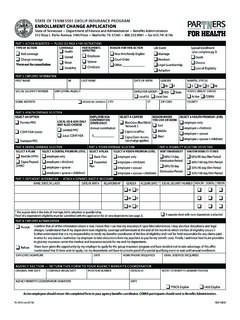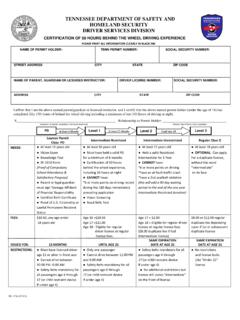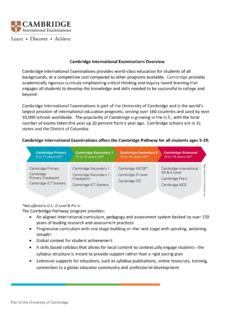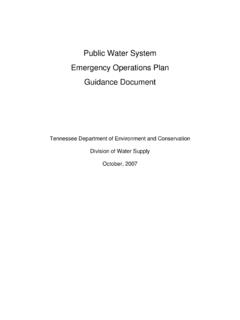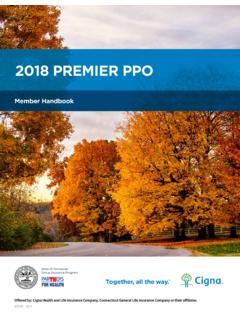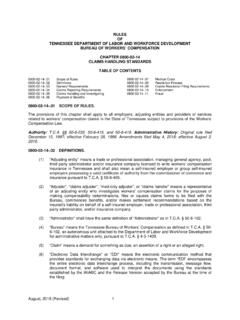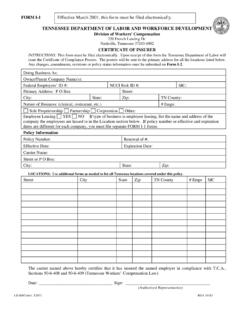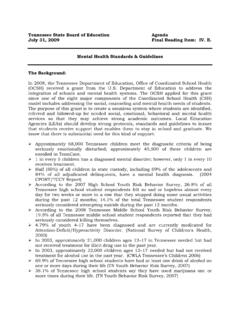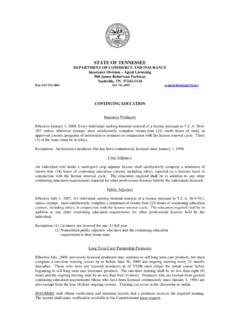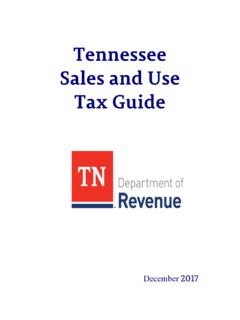Transcription of Isolation Guidance for Cases - Tennessee
1 Page 1 of 4 CDC RECOMMENDATIONS FOR Isolation AND QUARANTINE V23 January 24, 2022 Isolation Guidance for Cases TDH adopted guidelines for Isolation through promulgation of a new emergency rule on December 22, 2021 per TCA 14-4-101. TDH is posting new CDC Guidance , which was adopted after the emergency rule, for informational purposes. CDC Guidance is not legally binding. The new CDC Guidance provides that Cases must isolate for a minimum of 5 days after onset and may be released after they are without fever for 24 hours (without fever-reducing medication) and show improvement in symptoms. CDC recommends that Cases without symptoms must isolate through 5 days after their specimen collection date.
2 Regardless of symptoms, Cases should wear a well-fitting mask when around others for 10 days following onset/specimen collection. A case may consider using an antigen test towards the end of the 5-day Isolation period to make decisions about extending at-home Isolation . If the test result is positive, the individual should continue to isolate until day 10. If the test result is negative (or testing is not performed), they can end Isolation , but should continue to wear a well-fitting mask around others at home and in public until day 10. Notes: Some severely ill patients may need to isolate for a longer time period. Lingering cough or loss of taste or smell should not prevent a case from being released from Isolation .
3 A case with a positive test 10 90 days after their initial onset (or specimen collection date) does not need to re-enter Isolation as long as they do not develop new or worsening symptoms. Quarantine Guidance for Close Contacts Who DOES NOT need to quarantine at home? CDC recommends that close contacts do not need to quarantine if they meet any of the following: Are ages 18 or older and have received all recommended vaccine doses, including boosters and additional primary shots for some immunocompromised people. Are ages 5-17 years and completed the primary series of COVID-19 vaccines. Had confirmed COVID-19 within the last 90 days (you tested positive using a viral test) and remain without COVID-19 symptoms.
4 Recent Updates 01/24/22 Clarified that recommendations are from CDC 01/11/22 Added section with relevant Guidance for K-12 settings DAY 0 Symptom onset date or specimen collection date if not experiencing symptoms. Wear a mask around others to reduce risk of transmission. Minimum 5 days of Isolation at home DAY 6 released from Isolation ; return to regular activities. Continue to mask around others. 24 hours WITHOUT FEVER AND SYMPTOM IMPROVEMENT Continue masking around others for add l 5 days DAY 10 Page 2 of 4 NON-HOUSEHOLD CONTACT CDC recommends that contacts should wear a well-fitting mask around others for 10 days from the date of their last close contact with someone with COVID-19 (the date of last close contact is considered day 0).
5 Get tested at least 5 days after they last had close contact with someone with COVID-19. If they test positive or develop COVID-19 symptoms, they must isolate from other people and follow Isolation recommendations. HOUSEHOLD CONTACT A household contact is an individual who shares any living spaces with a case, including bedrooms, bathrooms, living rooms, kitchens, etc. If the contact can separate from the case within the home, CDC recommends that they can follow the non-household Guidance . To separate, the case 1) should never be in the same room as household members 2) should not share plates, cups, dishes, or phones with household members 3) should have their own bathroom (or conduct daily bathroom cleaning).
6 If the contact cannot separate from the case in the home, CDC recommends that they should get tested 5 days after initial exposure to the case and again 5 days after the end of the case s Isolation . The contact should wear a mask indoors in public for 10 days following last exposure. If they test positive, they must isolate. Who NEEDS to quarantine at home? CDC recommends that close contacts should quarantine if they meet any of the following: They are not vaccinated or have not completed a primary vaccine series. They are ages 18 or older and completed the primary series of recommended vaccine, but have not received a recommended booster shot when eligible.
7 Close contacts should quarantine regardless of whether the case was symptomatic. NON-HOUSEHOLD CONTACT CDC recommends that contacts should wear a well-fitting mask around others for 10 days from the date of their last close contact with someone with COVID-19 (the date of last close contact is considered day 0). They should quarantine at home for 5 days. Get tested at least 5 days after they last had close contact with someone with COVID-19. If they test positive or develop COVID-19 symptoms, they must isolate from other people and follow Isolation recommendations. DAY 0 Contact begins quarantine. Wear a mask when around others.
8 5 days quarantine at home DAY 10 Complete self-monitoring for symptoms. DAY 5 Get tested. If w/o symptoms or negative result, return to normal activities. Continue to wear a mask when around others. 5 additional days masking while around others Page 3 of 4 HOUSEHOLD CONTACT A household contact is an individual who shares any living spaces with a case. This includes bedrooms, bathrooms, living rooms, kitchens, etc. Quarantine start: Household contacts should quarantine as long as they are exposed to the case, and for a 5-day period beyond their last exposure. If the contact can separate from the case within the home, CDC recommends that they can follow the non-household Guidance .
9 To separate, the case 1) should never be in the same room as household members 2) should not share plates, cups, dishes, or phones with household members 3) should have their own bathroom (or conduct daily bathroom cleaning). If the contact cannot separate from the case in the home, CDC recommends that they should get tested 5 days after initial exposure to the case and again 5 days after the end of the case s Isolation . The contact should wear a mask when around others for 10 days following last exposure. If they test positive, they must isolate. Quarantine end: Once exposure is no longer occurring (either the case has completed their 5-day Isolation or the case and contact have separated within the home), then at-home quarantine can end after Day 5.
10 The contact must monitor for symptoms and wear a mask for 5 additional days. Notes: If a household contact develops symptoms of COVID-19, they become a case. They should begin Isolation as a case and consider getting tested. Household contacts will often need to remain at home longer than the initial case. If a case has been released from Isolation and symptoms return, household contacts do not need to restart the 5-day period as long as the case has completed the minimum 5-day Isolation and had symptom resolution for a minimum of 24 hours. Healthcare Personnel Healthcare personnel (including those working in long term care facilities) should refer to Guidance below for Isolation and quarantine Guidance : Interim Guidance for Managing Healthcare Personnel with SARS-CoV-2 Infection or Exposure to SARS-CoV-2 Interim Infection Prevention and Control Recommendations for Healthcare Personnel During the Coronavirus Disease 2019 (COVID-19) Pandemic Interim Infection Prevention and Control Recommendations to Prevent SARS-CoV-2 Spread in Nursing Homes DAY 0 Case s onset date.
